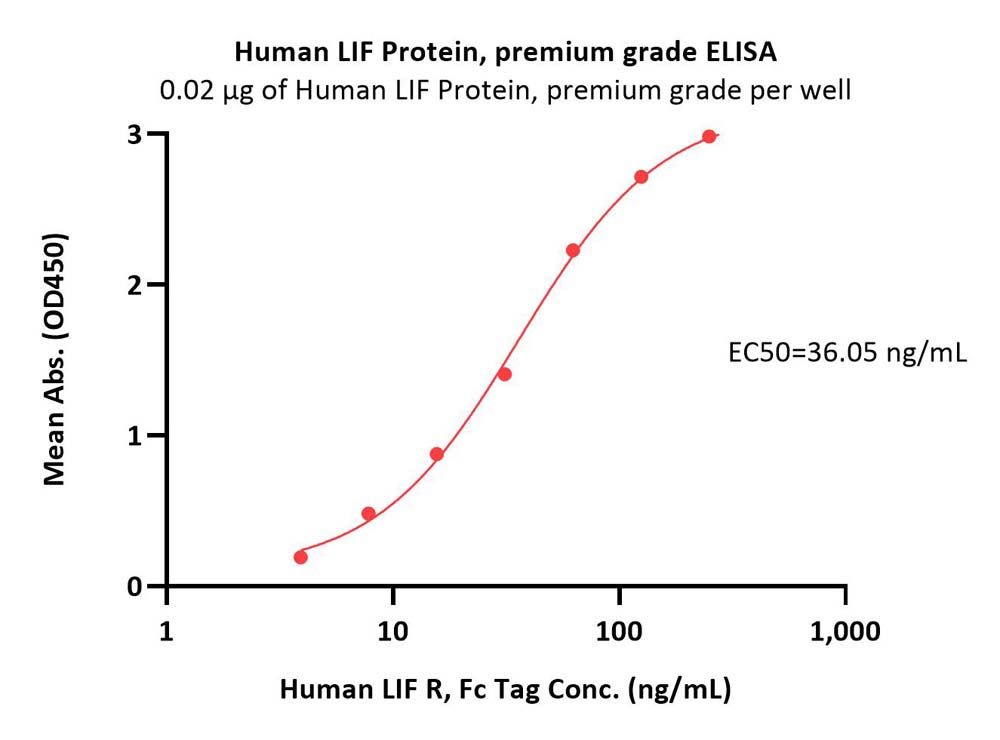分子别名(Synonym)
LIF,CDF,DIA,HILDA,MLPLI
表达区间及表达系统(Source)
Human LIF Protein, Tag Free (LIF-H521b) is expressed from human 293 cells (HEK293). It contains AA Ser 23 - Phe 202 (Accession # AAH69540.1).
Request for sequence
蛋白结构(Molecular Characterization)

This protein carries no "tag".
The protein has a calculated MW of 19.9 kDa. The protein migrates as 33-45 kDa under reducing (R) condition (SDS-PAGE) due to glycosylation.
内毒素(Endotoxin)
Less than 0.1 EU per μg by the LAL method.
无菌(Sterility)
Negative
纯度(Purity)
>90% as determined by SDS-PAGE.
制剂(Formulation)
Lyophilized from 0.22 μm filtered solution in PBS, pH7.4 with trehalose as protectant.
Contact us for customized product form or formulation.
重构方法(Reconstitution)
Please see Certificate of Analysis for specific instructions.
For best performance, we strongly recommend you to follow the reconstitution protocol provided in the CoA.
存储(Storage)
For long term storage, the product should be stored at lyophilized state at -20°C or lower.
Please avoid repeated freeze-thaw cycles.
This product is stable after storage at:
- -20°C to -70°C for 12 months in lyophilized state;
- -70°C for 3 months under sterile conditions after reconstitution.
质量管理控制体系(QMS)
电泳(SDS-PAGE)

Human LIF Protein, Tag Free on SDS-PAGE under reducing (R) condition. The gel was stained with Coomassie Blue. The purity of the protein is greater than 90%.
活性(Bioactivity)-ELISA

Immobilized Human LIF Protein, Tag Free (Cat. No. LIF-H521b) at 0.2 μg/mL (100 μL/well) can bind Human LIF R, Fc Tag (Cat. No. LIR-H4252) with a linear range of 4-500 ng/mL (QC tested).
Protocol
活性(Bioactivity)-Bioactivity CELL BASE

Human LIF Protein, Tag Free (Cat. No. LIF-H521b) stimulates the proliferation of TF-1 cells. The EC50 for this effect is 0.678 ng/mL (Routinely tested).
Protocol
 +添加评论
+添加评论背景(Background)
Leukemia inhibitory factor, or LIF, an interleukin 6 class cytokine, is a protein in cells that affects cell growth and development.Leukemia Inhibitory Factor has several functions such as cholinergic neuron differentiation, control of stem cell pluripotency, bone & fat metabolism, mitogenesis of factor dependent cell lines & promotion of megakaryocyte production in vivo.
Removal of LIF pushes stem cells toward differentiation, but they retain their proliferative potential or pluripotency. Therefore LIF is used in mouse embryonic stem cell culture. It is necessary to maintain the stem cells in an undifferentiated state, however genetic manipulation of embryonic stem cells allows for LIF independent growth, notably overexpression of the gene Nanog. LIF is not required for culture of human embryonic stem cells.























































 膜杰作
膜杰作 Star Staining
Star Staining











 Loading ...
Loading ...




